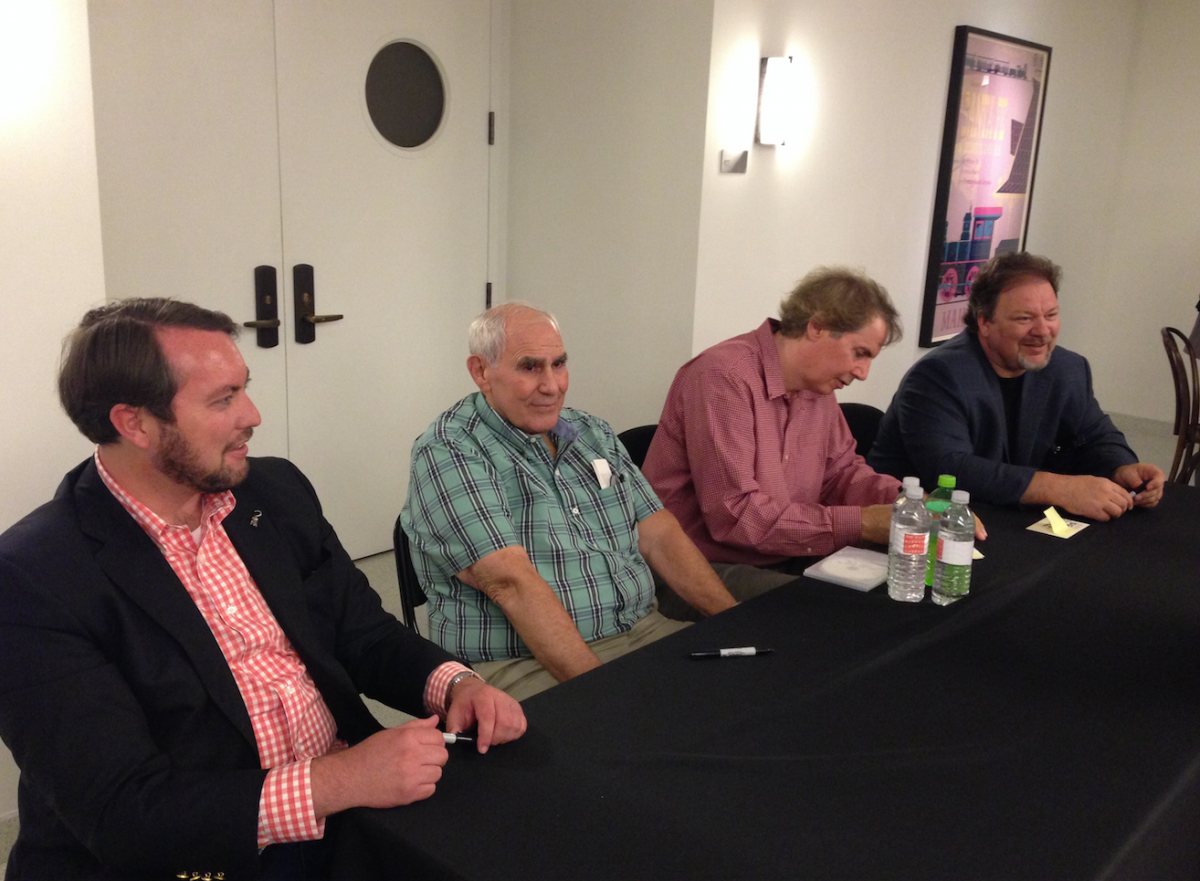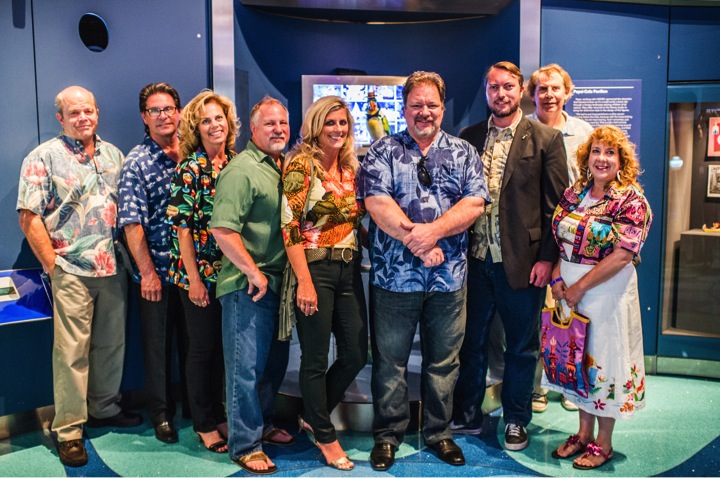On Saturday, June 21, 2014, a group of Disney fans and enthusiasts were treated to an intriguing and anecdotal discussion with four innovators of theme park technology.
The four panelists, though unique in their backgrounds, each found a common dedication in their work. Bill Butler, the head of creative for Garner Holt Productions (GHP), moderated the discussion with a refined knowledge of theme park history. David Feiten, a jack-of-all-trades animator, who has worked for Walt Disney Imagineering, Pixar Animation Studios, and GHP, shed light on the front line experience of Audio-Animatronics© programming. Disney Legend Orlando Ferrante, who played football at the University of Southern California alongside Ron Miller and Dick Nunis before embarking on a 40 year career with WED Enterprises (later Walt Disney Imagineering [WDI]), shared magical memories of working for Walt. Completing the panel was Garner Holt, one of the most important figures in theme park history of the last 35 years. Speaking with a cadence and reserve akin to such an accomplished visionary, he talked about being inspired by Disney Audio-Animatronics©.

Bill Butler was quick to remind guests that the artistic side of Imagineering and theme park production, that which we are most familiar with, is only “the tip of the iceberg.” A whole slew of technicians and specialists must work together to fully realize a theme park attraction; they have to do so in a realm beyond that of cinema. They must work in three, even four, dimensions of space and reality to create an engaging environment and an effective story.
A key area of interest today, as it was in the 1960s, is the field of Audio-Animatronics© (AA). The Disney artists who first developed the technology for attractions such as Great Moments With Mr. Lincoln and the Enchanted Tiki Room recognized the legacy that they were pioneering. Today, similar artists and technicians continue to push the boundaries of AA technology at companies like WDI and GHP.
One of Ferrante’s first assignments was to oversee the installation of the Enchanted Tiki Room at Disneyland, modestly describing himself as “the little guy in the corner taking notes.” He recalled Walt’s reaction to accusations of high production costs on the exhibit: “It’s like owning a yacht,” Walt said, “If you want to know how much it’s going to cost, you shouldn’t own it.” The Enchanted Tiki Room was the first Disney attraction to incorporate sophisticated AA technology. Such developments would explode onto a much larger scale with the exhibits at the New York World’s Fair in 1964-65, including the human characters in Great Moments with Mr, Lincoln and the Carousel Theater of Progress.
Garner Holt was keen to remind the audience that the early AA figures developed by WED were experimental, often handmade, and quite prototypical in nature. Each new figure or attraction pushed the boundary a little more. The Disney crew built these early figures in-house, often consulting with outside sources (Ferrante mentioned collaborating with artificial limb companies on Great Moments with Mr. Lincoln). In the wake of the New York World’s Fair, Disney founded MAPO (Manufacturing and Production Organization), a wholly owned subsidiary company to build animatronics.
By the time of Walt Disney World’s development, however, AA figure counts were very high, and greater efficiency was required for such a level of production. Disney began by collaborating with the aerospace industry to develop methods of creating multiple parts that were uniform in design and application, allowing for a more easily maintained system. This was the beginning of Disney’s outsourcing AA production.
The timing was perfect for young Garner Holt to come on the scene in the late 1970s. As animatronic production became more uniform and companies like Disney began to outsource, entrepreneurs like Holt took advantage. Beginning as the sole employee, he built everything himself. Eventually, GHP became one of the most successful AA companies in the world, its earliest Disney jobs involving parade floats and window displays on Main Street, USA. The company’s big break came with the new Haunted Mansion Holiday in 2001, for which GHP produced all the AA figures. Ever since, the company has been the primary supplier for Disney. Orlando Ferrante commented that visiting the GHP facilities was “like being back at WED or MAPO in the old days,” which prompted Butler to joke, “A few years ago, MAPO changed its name to Garner Holt Productions.”
The task of actually programing AA figures fell upon animators like David Feiten. With a background in cinematic hand drawn animation, Feiten had to learn the fundamentals of a greater three-dimensional dynamic in AA characters. He realized that characters would need to be exaggerated more to read better from a distance. The process is long and experimental, with constant adjustment required, a process Feiten compared to tuning a car. Motions had to be layered out, one function, one body part at a time, beginning with the head. With much practice came the finessed skill, and Feiten would apply such to many attractions over the years, including Splash Mountain and Star Tours at Disneyland.
 All panelists agreed that “there’s no shortcuts to a good show,” whether it be work on a single figure, or a highly complex E-ticket adventure, all attractions take time and effort to be successful. All figures, prior to park installation, must be pre-programmed in a studio environment and continuously operated for at least 72 hours to merit such placement. Inevitably, new problems are discovered after attractions are installed and tested by technicians and artists like Feiten. And they must work as efficiently as possible to meet park deadlines to open an attraction on time. In the end, as Holt attested, each figure is an original work of art.
All panelists agreed that “there’s no shortcuts to a good show,” whether it be work on a single figure, or a highly complex E-ticket adventure, all attractions take time and effort to be successful. All figures, prior to park installation, must be pre-programmed in a studio environment and continuously operated for at least 72 hours to merit such placement. Inevitably, new problems are discovered after attractions are installed and tested by technicians and artists like Feiten. And they must work as efficiently as possible to meet park deadlines to open an attraction on time. In the end, as Holt attested, each figure is an original work of art.
When asked about the future of AA technology, Holt pointed to the realms of greater interactivity between characters and guests. He mentioned a recent development at GHP involving an AA figure that could communicate via sign language. He went on to say that higher levels of realism and personal engagement will lead the latest evolutions in animatronic technology. Holt also professed a keen trust in the younger generations of today, who have already demonstrated a strong talent for practical ingenuity and creative design by building things in their own garages and backyards.
At the program’s conclusion, Joanna Miller, granddaughter of Walt Disney and daughter of Diane Disney Miller, took to the stage with the museum’s Director of Collections and Exhibitions Michael Labrie. Together they thanked Garner Holt and his team for the wonderful gift of the Barker Bird known as Pepe del Presidio, now on display and delighting guests in Gallery 9. “It is a special moment in [our] history,” Miller said.

